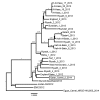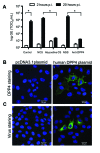Isolation of MERS coronavirus from a dromedary camel, Qatar, 2014
- PMID: 25075761
- PMCID: PMC4111206
- DOI: 10.3201/eid2008.140663
Isolation of MERS coronavirus from a dromedary camel, Qatar, 2014
Abstract
We obtained the full genome of Middle East respiratory syndrome coronavirus (MERS-CoV) from a camel in Qatar. This virus is highly similar to the human England/Qatar 1 virus isolated in 2012. The MERS-CoV from the camel efficiently replicated in human cells, providing further evidence for the zoonotic potential of MERS-CoV from camels.
Keywords: MERS; Qatar; camel; coronavirus; viruses.
Figures


References
-
- Hemida MG, Perera R, Wang P, Alhammadi MA, Siu LY, Poon LL, et al. Middle East respiratory syndrome (MERS) coronavirus seroprevalence in domestic livestock in Saudi Arabia, 2010 to 2013. Euro Surveill. 2013;18:20659 . - PubMed
Publication types
MeSH terms
Substances
Associated data
- Actions
LinkOut - more resources
Full Text Sources
Other Literature Sources

